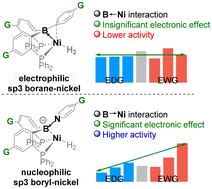Distinct electronic effects of borane– and boryl–nickel complexes for catalyzing H2 activation†
Abstract
Over the last decade, boron-based complexes have been emerging as unique catalysts for the bifunctional activation of small molecules. To reveal the difference in the electronic regulatory factors on the design of electrophilic borane and nucleophilic boryl transition metal catalysts, the DPB–Ni complex was selected as a representative catalyst to investigate their performance in H2 activation using density functional theory (DFT) calculations. Our findings reveal that the nucleophilic sp3 boryl–nickel catalyst had a higher activity than the electrophilic borane–nickel catalyst for H2 activation. The Lewis basicity of boryl could be enhanced by the dative pyridine group, increasing the activity of the boryl–nickel catalyst. In the electrophilic sp3 borane–nickel system, the electron-withdrawing group (EWG) enhanced the M→B dative bond, suppressing the cleavage of the B–Ni bond during the H2 activation, while the formation of the B–H–Ni bond was facilitated by the EWG group. The electron-donating group (EDG) resulted in similar influences. These compromised results surprisingly led to an insignificant electronic effect on the activity. In the nucleophilic sp3 boryl–nickel system, the electronic effect of the ligands significantly influenced the catalytic performance. The EDG increased the nucleophilicity of the boryl to assist H2 activation and enhanced the electron density of the metal center for H2 oxidative addition, significantly improving the activity; whereas, the EWG group decreased the reaction activity. The distinct electronic effect revealed by this study will be helpful to advance the rational design of boron-based transition metal catalysts for bifunctional catalysis and their applications.

- This article is part of the themed collections: 2023 Inorganic Chemistry Frontiers Review-type Articles and 2023 Inorganic Chemistry Frontiers HOT articles


 Please wait while we load your content...
Please wait while we load your content...